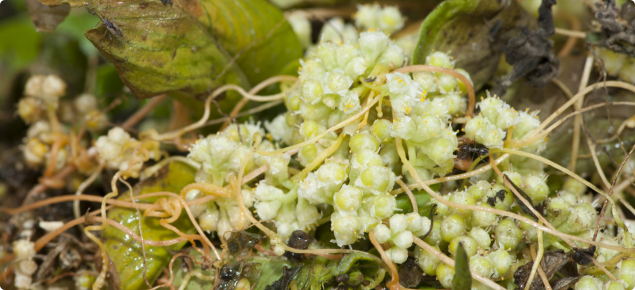Form: vine — annual
Status: present in WA
Golden dodder is a native of North America. It is a parasitic plant that obtains its nourishment entirely from host plants.
Appearance
Golden dodder is an annual plant. It has only tiny scale leaves that contain no chlorophyll and, therefore, cannot photosynthesise. Instead it obtains nutrients by forcing specialist organs, called haustoria, into the tissue of host plants and taking host sap as a nutrient source.
Stems: Golden dodder has smooth, hairless, thread-like stems about one millimetre thick. These are usually bright yellow in colour (hence the name golden dodder), but may occasionally be green or pink. The stems twine round their host in an anti-clockwise direction. Parts of the stem may be coiled with other parts hanging free.
Flowers: Creamy white or (rarely) pink. They are minute and crowded in dense spherical heads. When the flowers die, seed capsules with four grey-brown irregularly round seeds can be seen.
Seeds: Similar to lucerne and clover and are sometimes found as a seed contaminant that is difficult to remove during cleaning.
Agricultural and economic impact
A parasitic weed of lucerne, horticultural crops, legumes and broadleaved weeds. Severe yield reductions occur when crops are infested with golden dodder. It is a particular threat in medium to high rainfall and irrigation areas. It is seldom found on woody plants, grasses or cereals.
Lucerne or other hay containing golden dodder seeds or plant parts may not be sold or removed from the property. It is a known trade barrier if found in exported commodities.
Golden dodder is not readily eaten by stock. It is not poisonous, but cattle and horse which are forced to eat it often develop digestive problems.
Declared pest category
The Western Australian Organism List (WAOL) contains information on the area(s) in which this pest is declared and the control and keeping categories to which it has been assigned in Western Australia (WA). Search for golden dodder in the WAOL using the scientific name Cuscuta campestris.
Requirements for land owners/occupiers and other persons
Requirements for land owners/occupiers and other persons if this pest is found can be sourced through the declared plant requirements link.
Search > detect > report
| MyPestGuide™ Reporter | Pest and Disease Information Service (PaDIS) |
Control method
Control methods for this declared plant can be found through the golden dodder control link.



